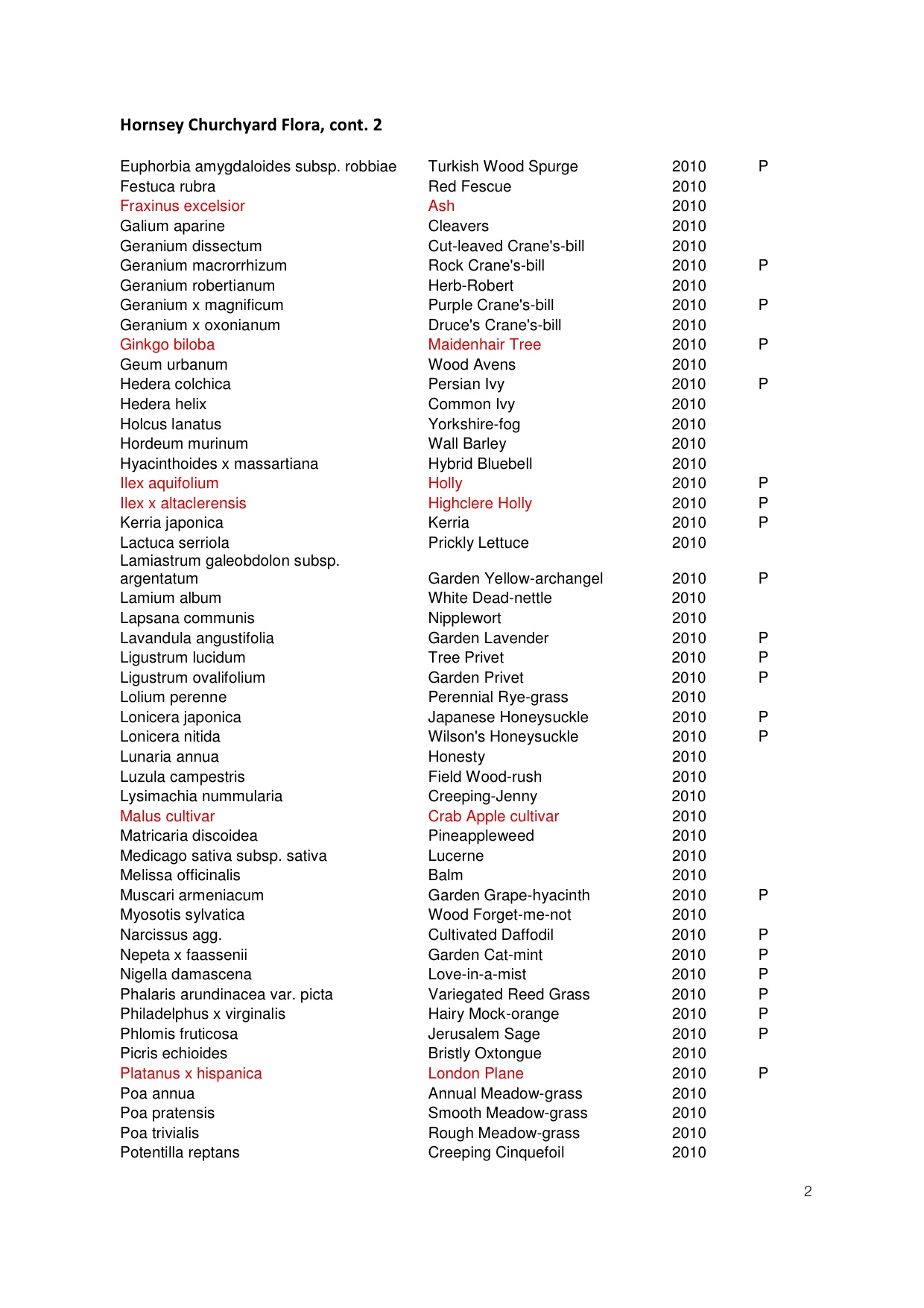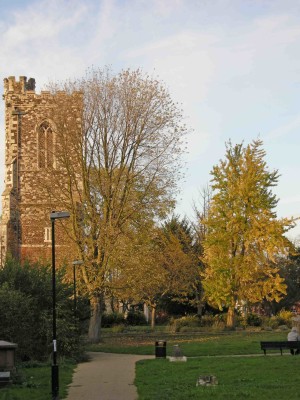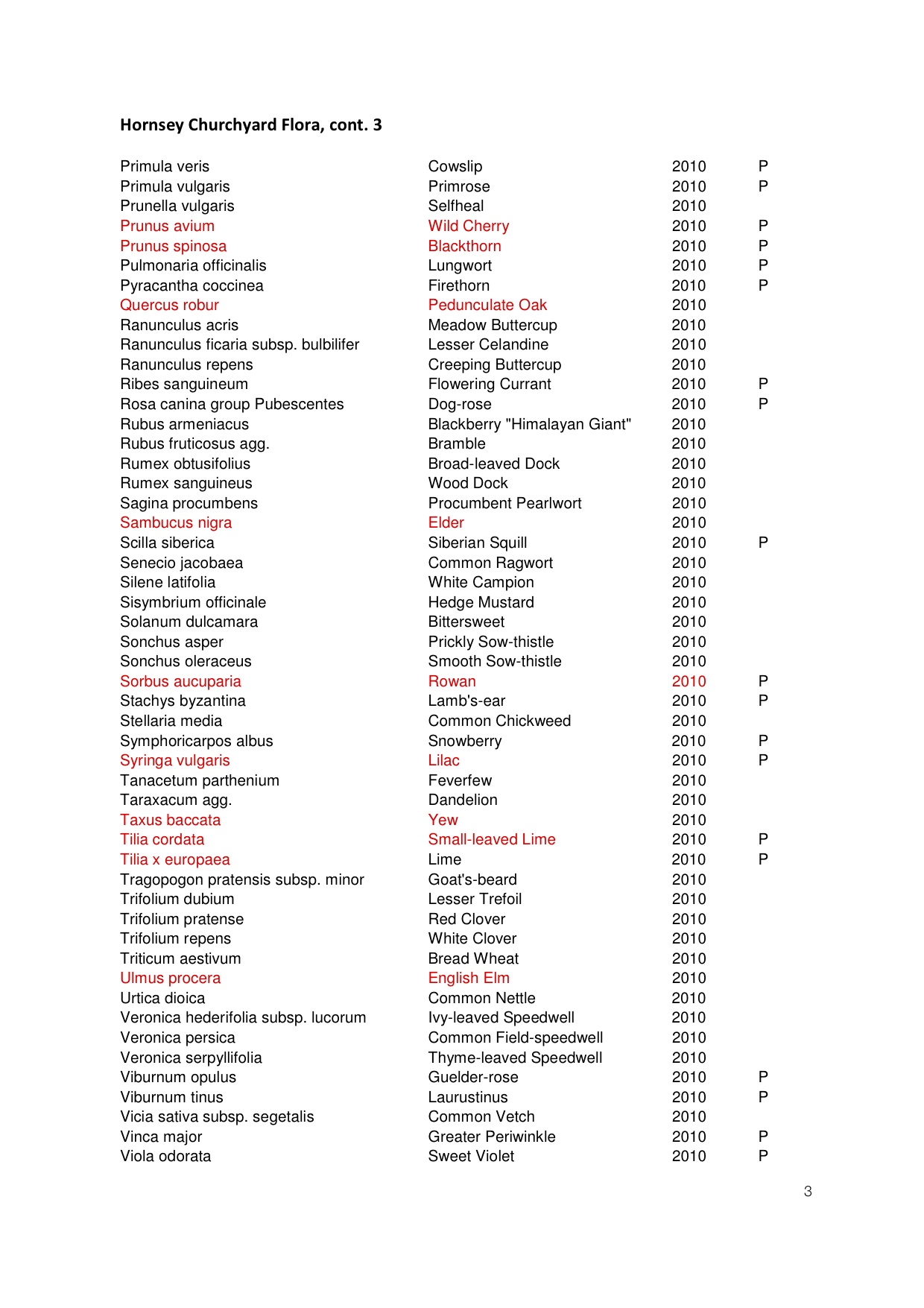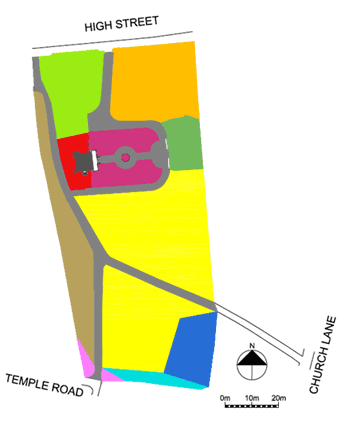
Churchyard Wildlife
Area 1 – Woodland, south-east corner
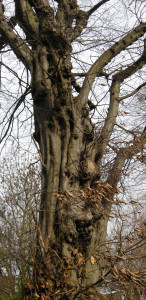 This area has a small but interesting collection of native trees, including Hornbeam, Oak, Hawthorn and Ash. They would appear to have grown up after the land became part of the churchyard c. 1840, possibly developing from a former hedge.
This area has a small but interesting collection of native trees, including Hornbeam, Oak, Hawthorn and Ash. They would appear to have grown up after the land became part of the churchyard c. 1840, possibly developing from a former hedge.
The Hornbeams could be remote descendants from the ancient woodland of Middlesex, where this tree occurred frequently (see also Highgate Wood and Queens Wood). The Hawthorns near the south boundary and elsewhere in the churchyard may be descended from the ‘quickthorn’ hedge around the churchyard which is mentioned in 18th century documents and appears in early 19th century views.
Spring flowers include bluebells (Spanish, although some native ones were planted c. 2000), buttercups (creeping and meadow), cow parsley, alkanet.
Policy
- – Removal of ash and sycamore seedlings.
- – Maintenance of undergrowth, but keeping a perimeter path to provide access to the row of tombs along the east border (these included the Listed ‘Slave tomb’ which is frequently visited).
- – Strengthening the boundary edges with native hedge plants.
Area 2 – South Boundary
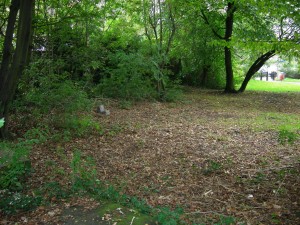 An overgrown area with Brambles including the ‘Himalayan Giant’ Blackberry. Trees (including a mature Black Poplar and a Sycamore) along this boundary have been lost in recent years; a Willow (Salix) was planted in spring 2010 and there is also a Horse Chestnut sapling. Undergrowth includes Vinca major (probably a garden escape).
An overgrown area with Brambles including the ‘Himalayan Giant’ Blackberry. Trees (including a mature Black Poplar and a Sycamore) along this boundary have been lost in recent years; a Willow (Salix) was planted in spring 2010 and there is also a Horse Chestnut sapling. Undergrowth includes Vinca major (probably a garden escape).
Policy
- – To limit expansion of brambles and undergrowth over the tombs in this area and discourage their expansion over the adjoining grassland.
AREA 3 – Temple Road entrance
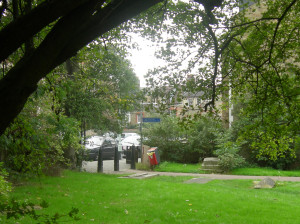 Lilac tree east of the entrance; Holly and Hawthorn hedge (planted c. 2006) to the west, Buddleia and Elder by adjacent house wall. Undergrowth: Broad leaved Dock, Nettle.
Lilac tree east of the entrance; Holly and Hawthorn hedge (planted c. 2006) to the west, Buddleia and Elder by adjacent house wall. Undergrowth: Broad leaved Dock, Nettle.
Policy
- – Strengthening and expanding the Holly and Hawthorn hedge to fill the whole corner as a deterrent to fly tipping.
- – Maintaining the Buddleia and Elder at a reasonable size by appropriate pruning.
AREA 4 – West border
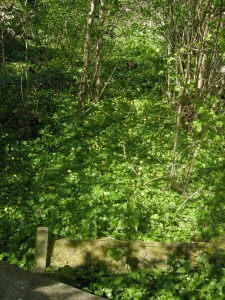 This narrow strip between the main N-S path and the garden wall on the west side has several tombs of interest, including some large chest tombs. Three compost containers are sited near the wall, largely hidden by trees. Wood piles are also maintained in this area. The south end of the area near Temple Road, which gets plenty of sun, has rough grass with nettles and docks. Trees near the wall include a Maple and a Horse Chestnut seedling. The middle area SW of the tower is densely overgrown with elm suckers, successors to the Elm
This narrow strip between the main N-S path and the garden wall on the west side has several tombs of interest, including some large chest tombs. Three compost containers are sited near the wall, largely hidden by trees. Wood piles are also maintained in this area. The south end of the area near Temple Road, which gets plenty of sun, has rough grass with nettles and docks. Trees near the wall include a Maple and a Horse Chestnut seedling. The middle area SW of the tower is densely overgrown with elm suckers, successors to the Elm
trees shown on old views, also Holly, Elder, Lime hybrid (Tilia cordata), Brambles and Nettles. In spring this area is remarkable for its display of Celandines. The northern end, which is heavily overshadowed by the tower and the Hollies on the other side of the path, has a variety of trees, including a Sorbus (possibly Sorbus thuringiaca), and Crab Apple, also numerous Elder and Maple seedlings, and dense ground cover of Ivy.
Policy
- – Annual cutting of the areas of grass and nettles.
- – Sufficient clearing of undergrowth to maintain tombs.
- – Removal of seedlings growing in tombs.
- – Encouragement of brambles in some areas as a deterrent to inappropriate activity.
- – Cutting back of Holly overhanging the path.
- – Improvement of entrance from High Street to deter litter.
Area 5 – Meadow area north and south of Church Lane path
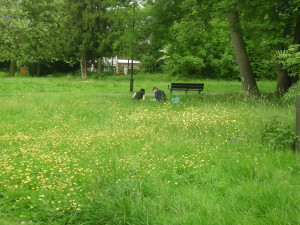 This open, sunny area has relatively few tombs and is popular for dog walking and picnics. Two seats are sited beside the Church Lane path An informal ‘desire line’ path runs diagonally from the Temple Road entrance toward Church Lane. Noticeably damp patches remain in some areas after the weather is wet.
This open, sunny area has relatively few tombs and is popular for dog walking and picnics. Two seats are sited beside the Church Lane path An informal ‘desire line’ path runs diagonally from the Temple Road entrance toward Church Lane. Noticeably damp patches remain in some areas after the weather is wet.
The range of flowering spring and summer plants includes Buttercup, Cow Parsley, Primrose, Ivy-leaved speedwell (Veronica hederifolia), Native cowslip (Primula veris), Dandelion (Taraxacum officianalis), Red and White clover, and various grasses. Mouse-eared chickweed (Cerastrum pontanum) is found near tombs.
Notable trees: near the Tower: a very fine and large Norway Maple, remarkable for its brilliant autumn colour. Near the E fence, a Field Maple and a London Plane. To the North of the Plane is a Wild Cherry, planted November 2010, to commemorate Joan Schwitzer, first chairman of FoHCT.
Policy
- – Continuation of the grass cutting regime, with a single cut in late summer after flower seed has set, followed by raking up the grass cuttings, was introduced in 2010.
- – Monitoring of Wild Cherry to ensure adequate watering during first year of growth.
- – Long term monitoring of plant species to gauge effect of grass cutting regime and possible variations in damp areas.
- – Removal of ash seedlings growing out of tombs.
- – Hedge planting by the school boundary fence.
Area 6 – South, west and north of the tower
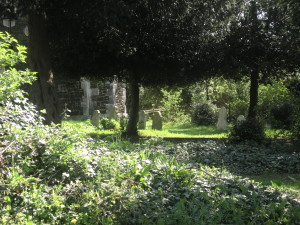 This small area, separated by railings form the path, has some of the oldest standing tombstones. A Dog Rose grows along the railings, where there are also some small Yew bushes. The main notice board stands here.
This small area, separated by railings form the path, has some of the oldest standing tombstones. A Dog Rose grows along the railings, where there are also some small Yew bushes. The main notice board stands here.
Policy
- – Grass to be kept short by regular mowing, to provide easy access to tower and to keep tombs visible.
- – Yews to be encouraged to grow into a small hedge.
- – Rose to be pruned regularly.
Area 7 – North-west quarter
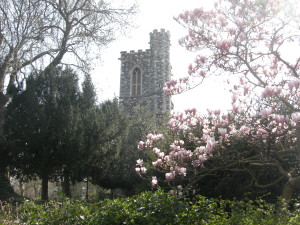 This is a confused area owing to its earlier history. By the early 19th century there was a row of substantial chest tombs, some of them raised up on mounds because of the waterlogged ground.
This is a confused area owing to its earlier history. By the early 19th century there was a row of substantial chest tombs, some of them raised up on mounds because of the waterlogged ground.
Their collapsed remains account for the irregular surface. An impressive ash tree, the largest tree in the churchyard, is sited on a mound near the central path from the High Street. Plants found here include Wavy Bittercress. West of the Ash are a group of Holly trees, some of them Highclere Hollies, which originally flanked a path to the North door of the church from the NW corner of the churchyard.
They have now grown into substantial trees, their dense foliage and berries attracting many birds. In a corner near the NW entrance to the churchyard is a fine Magnolia tree, somewhat crowded by a young Yew tree and large Holly bush. There is also a mature Hawthorn close to the High Street hedge.
Policy
- – Annual grass cutting and monitoring as for area 4.
- – Clearance of some undergrowth around tombs.
- – Ivy undergrowth to be confined to area below Hollies.
- – Remove Holly shoots at base of trees.
- – Consider planting more Hollies to emphasise line of old drive.
- – Remove Yew and Holly near the magnolia.
- – Watching brief for Ash, which has shed branches recently.
- – For the High Street hedge see below, area 8.
Area 8 – North-east quarter
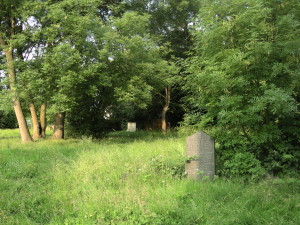 A mixed area of grass and mature trees, with a large number of ledger tombs, and four chest tombs, including the Listed tomb of Samuel Rogers in the NE corner.
A mixed area of grass and mature trees, with a large number of ledger tombs, and four chest tombs, including the Listed tomb of Samuel Rogers in the NE corner.
The many trees include a mature Hornbeam, a large Yew, and a somewhat confused but picturesque central tangle with Red Horse Chestnut, Hawthorn, Yew, Hornbeam, Cypress, Sycamore and Prunus. The Hawthorns include a Midland Hawthorn. There is a young Service tree (Sorbus domestica) near the Infant school entrance.
The hedge along the High Street, planted 2004, has mixed hedgerow plants including Hawthorn, Rose, Bramble, Hazel, Yew, Privet, Guelder rose, Field Maple. There are two Buddleias flanking the main entrance from the High Street.
Policy
- – Annual grass cutting and monitoring as for area 4.
- – Limited clearing of undergrowth around tombs.
- – Regular cutting back of High Street hedge to encourage dense growth at bottom.
- – Pruning of Buddleias.
- – Cutting back of Elders by school boundary to allow more light into the NE corner.
Area 9 – Orchard
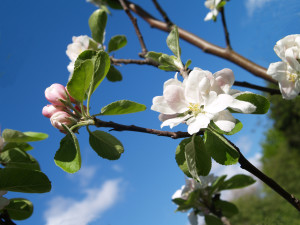 This is a railed area which contains a number of tombs, lying between the Garden of Remembrance and the school fence.
This is a railed area which contains a number of tombs, lying between the Garden of Remembrance and the school fence.
The railings were erected c.2003 to provide a ‘dog free’ area adjacent to the Infant School entrance. The surfaces have proved too uneven for regular use as an outdoor area by the school, as was originally intended. The area is now being developed as an ‘orchard’. Four apple trees (Jonagold and James Grieve) were planted in 2010.
Policy
- – Annual grass cutting and monitoring as for area 4.
- – Annual, or possibly more frequent, grass cutting.
- – Monitoring of apple trees.
- – Removal of the Goat Willow by school fence which is growing out of a tomb and overshadows the apple trees.
- – Removal of elders and other plants around chest tombs.
- – Further planting: possibly fruit bushes along southern railings.
Area 10 – Garden of Remembrance
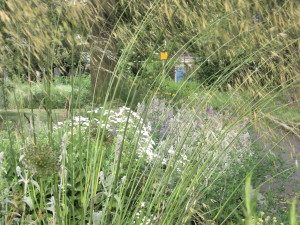 This was created in 1950, on the site of the old church, as the Borough of Hornsey’s official Second World War Memorial, as is recorded on a circular plaque now attached to the wall to the north of the tower.
This was created in 1950, on the site of the old church, as the Borough of Hornsey’s official Second World War Memorial, as is recorded on a circular plaque now attached to the wall to the north of the tower.
The layout consists of two lawns surrounded by flower beds, flanking a path leading E-W to the tower. The path widens to a central circle containing a circular bed. The flower beds all have low stone retaining walls. Photographs show that the original planting consisted of low bedding plants.
At an early stage two Ginkgo trees were planted half way along each of the north and south beds. They are now the chief features of the garden, their yellow foliage making a fine show in the autumn. There were also two trees on each of the lawns; the eastern ones have disappeared, the fairly small western ones (Crataegus prunifolia) survive, but in an elderly state.
In the 1970s bedding plants were replaced by bushes, largely evergreen, which over thirty years grew to an inappropriate size and density. Various ‘accidental’ plants observed in 2010 include a Fern in the wall below the memorial plaque, and in the lawns: Yellow archangel; Sheeps sorrel; (N Side): and Good Friday grass (Luzuola campestris), Clover, Prickly oxtongue (S side). Renovation began in 2008 with the entire replanting of the South border, designed as a ‘Scented walk’ with plants, including Stipa gigantea, Stipa tenuissima, Phlomis, Stachys, Sedum, Nepeta, and numerous herbs, selected for their ability to withstand drought and provide year round interest (see appendix 6.8). Replanting of the rest of the Garden began in 2010-11, retaining some of the existing shrubs, including several roses and the cotoneasters at the corners of the central circle.
| List of new Garden of Remembrance plants, planted in the south border, 2008 – 9 |
| Achillea filipendulum gold plate |
| Caryopteris heavenly blue |
| Euphorbia characias wulfenii |
| Euphorbia robbiae |
| Festuca glauca |
| Foeniculum vulgare |
| Helianthemum Rhodanthe carneum |
| Helichrysum italicum |
| Heuchera chocolate ruffles |
| Heuchera Fireworks |
| Hyssop |
| Iris sibirica |
| Lavendula stoechas |
| Lonicera fragrantissima |
| Nepeta 6 hills giant |
| Perovskia blue spire |
| Phlomis fruticosa |
| Rosmarinus officinalis Miss Jessop |
| Rudbeckia Goldsturm |
| Salvia officinalis purpurea |
| Santolina chamaecyparissus |
| Sedum spectabile |
| Sedum autumn joy |
| Stachys byzantina |
| Stipa gigantea |
| Stipa tenuissima |
| Thymus citriadocus Doone Valley |
| Thymus silver queen |
| Verbena bonariensis |
| List of new Garden of Remembrance plants, planted in the north west and central beds, 2011 – 12 |
| PERENNIALS |
| Acanthus Spinosus |
| Alcimilla Mollis |
| Ajuga Reptans Atropurpurea |
| Anenome hybrida Honorine Jobert |
| Asters: Alice HaslamBlue Sapphire |
| Bergenia: Bressingham WhiteRotblum |
| Erigeron Karvinskianus |
| Euphorbia: Amygdaloides RobbiaeHumpty Dumpty |
| Helleborus Argutifolius |
| Heuchera (Various) |
| Lavendula Hidcote |
| Monarda Panama |
| Nepeta Six Hills Giant |
| Perovskia Blue Spire |
| Persicaria Macrophylla |
| Phlomis Bronze Flamingo |
| Ruta Graveolens |
| Salvia Nemrosa Carradona |
| Sedum: Spectabile BrilliantAutumn JoyMatrona |
| Stachys Silver Carpet |
| GRASSES |
| Stipa Gigantia |
| Stipa Arundinacea Anemanthele Lessonia |
| SHRUBS |
| Berberis Thunbergii Atropupurea |
| Chaenomoles Geisha Girl |
| Choisya Ternate Sundance |
| Cotoneaster Horizontalis |
| Euonymus Fortunei Silver Queen |
| Euonymus Japonicus Ovatus Aureus |
| Fuchsia Magellanica |
| Mahonia Japonica Charity |
| Rosa Madame Alfred Carrière |
| Rosa Peace |
| Rosa Alba: The Alexandra Rose |
| Sarcococca Hookeriana |
| Viburnum Carlesii Diana |
Policy
- Annual grass cutting and monitoring as for area 4.
- Completion of the replanting of the Garden to create a unified effect, with open views through to the Tower
- Appropriate planting for the central circle and for the planting troughs on the raised area by the tower entrance.
- Regular maintenance, including winter mulching, appropriate pruning and cutting back etc.
- Regular cutting of the grass areas, but with attention to any plants of special interest.
- Watching brief for Ginkgos, especially the southern one which has a split trunk.
- Consideration of appropriate repair/maintenance of the walls supporting the raised area in front of the tower.
Area 11 – Paths
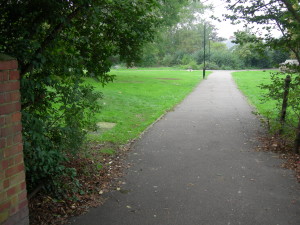 The N-S (cycle) path has a bound gravel surface; the E-W path to Church Lane is tarmac. A one-metre-wide strip of grass on each side of these paths is mown regularly. This draws attention to the different policy for the meadow grass beyond.
The N-S (cycle) path has a bound gravel surface; the E-W path to Church Lane is tarmac. A one-metre-wide strip of grass on each side of these paths is mown regularly. This draws attention to the different policy for the meadow grass beyond.
Policy
- – Continuation of the mowing of these strips through regular contact with Haringey Parks Dept
Area 12 – Flora
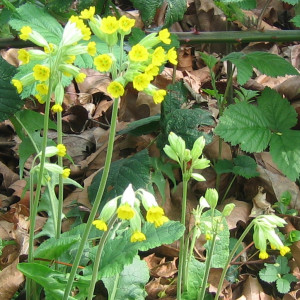 The Flora of the churchyard is of various origins. It includes many native plants, together with garden escapes. The variety is demonstrated by the wild plants and grasses in flower observed in June 2010, which included Lucerne, Meadow foxtail, Yorkshire Fog grass, Wall barley, Rye grass, Silk knot grass, Barren brome (Bromus sterilis), Creeping buttercup, Meadow buttercup, Woody nightshade, Dog rose, Feverfew (double), Sow Thistle, Nipplewort, Creeping cinquefoil, Jack go to bed at Noon, Pineapple weed (in cracks between paving stones), Cleaver, Daisy, Herb Robert, Elder, Dandelion, White clover, Common nettle. Likewise both the trees and the plants in the Memorial Garden include both native and exotic species. See Appendix 6.7 for a list of trees and wild plants and Appendix 6.9 for a list of new Garden of Remembrance plants.
The Flora of the churchyard is of various origins. It includes many native plants, together with garden escapes. The variety is demonstrated by the wild plants and grasses in flower observed in June 2010, which included Lucerne, Meadow foxtail, Yorkshire Fog grass, Wall barley, Rye grass, Silk knot grass, Barren brome (Bromus sterilis), Creeping buttercup, Meadow buttercup, Woody nightshade, Dog rose, Feverfew (double), Sow Thistle, Nipplewort, Creeping cinquefoil, Jack go to bed at Noon, Pineapple weed (in cracks between paving stones), Cleaver, Daisy, Herb Robert, Elder, Dandelion, White clover, Common nettle. Likewise both the trees and the plants in the Memorial Garden include both native and exotic species. See Appendix 6.7 for a list of trees and wild plants and Appendix 6.9 for a list of new Garden of Remembrance plants.
A variety of management regimes have been adopted to encourage biodiversity and enhance the distinctive character of different parts of the churchyard. The FoHCT have divided the churchyard and garden of remembrance into a number of Areas to reflect their differing characters. These and the policies being adopted for each area are described in the ‘Churchyard ecological areas’ section of this website.
List of Trees and Wild Plants recorded by David Bevan from three surveys made in 2010.
Bird and insect life
 The policies detailed below for maintaining and increasing biodiversity of plant life are vital for also for encouraging diverse bird and insect life. Significant aspects of the churchyard for this purpose include:
The policies detailed below for maintaining and increasing biodiversity of plant life are vital for also for encouraging diverse bird and insect life. Significant aspects of the churchyard for this purpose include:
Large trees (in contrast with those in neighbouring streets and gardens), provide opportunities not only for nesting birds, but perching places, for example for flocks of starlings observed in autumn 2010.
Berry bearing trees such as Yew, Hawthorn and Holly, which provide food for birds.
Undergrowth especially Ivy and Nettles, which are valuable for insect life.
Piles of rotting wood (maintained around the edges of the site) which encourage insects.
Plants which encourage butterflies, such as Buddleia, and flowering plants which attract insects, such as the herbs in the Garden of Remembrance.
Policy
- – Closer observation of bird and insect life in the churchyard by means of special studies.
- – Appropriate choice of plants, for example in the replanting of the Garden of Remembrance.
- – Maintenance of areas of undergrowth and nettles.
- – Maintenance of wood piles.

